We use cookies to make your experience better. To comply with the new e-Privacy directive, we need to ask for your consent to set the cookies. Learn more.
Literacy Leaders: 10 Minute Lessons for Phonological Awareness
Phonological awareness refers to an awareness of sounds in the spoken word and relates only to speech sounds, not to letter recognition. In other words, it is learning to listen for sounds, not look for letters. When a child has a strong sense of phonological awareness it can have a positive effect on both their reading and spelling.
Phonological awareness skills are ordered from very simple tasks to more complex tasks rhyme providing, rhyme categorization, sound providing, sound categorization, blending, segmentation, deletion, and substitution. Literacy Leaders provides activities for every level of awareness. Rhyme providing is when you have the child say a word that rhymes with _____. Rhyme categorization is when you ask a child if certain words rhyme. Sound providing asks the child what sound they hear at the beginning, end or middle of a word, and sound categorization asks the child which word begins with ____ or has the same ending sound as_____. Blending incorporates compound words, syllables, and phonemes; segmentation deals with sentences, syllables, and phonemes; deletion deals with compound words, syllables, and phonemes; and substitution deals with the same.
You can help your child improve skills in the area of phonological awareness in only 10 minute lessons. Choose one or two activities appropriate for a specific phonological skill determined by the skill level at which your child is ready to work. All activities are auditory and should never be presented visually. These 10 minute lessons should be done from 3 to 5 times weekly; a struggling reader should do them 5 times weekly.
For the best results, this program should be used with a structured phonics program. For this reason, a chart is provided which shows the correlation between Literacy Leaders and 3 organized phonics programs Explode the Code, Primary Phonics, and TouchPhonics. These programs are all published by EPS (as is this Literacy Leaders program). The chart tells you which books from each program (and even which particular pages) correspond to the lessons in this book.
This program can be used with at risk students of any age, but all children will benefit from use at an early age. ~ Donna
| Product Format: | Softcover Book |
|---|---|
| Brand: | Educators Publishing Service |
| Grades: | PK-2 |
| ISBN: | 9780838826997 |
| Length in Inches: | 11 |
| Width in Inches: | 9 |
| Height in Inches: | 0.75 |
| Weight in Pounds: | 1.45 |

